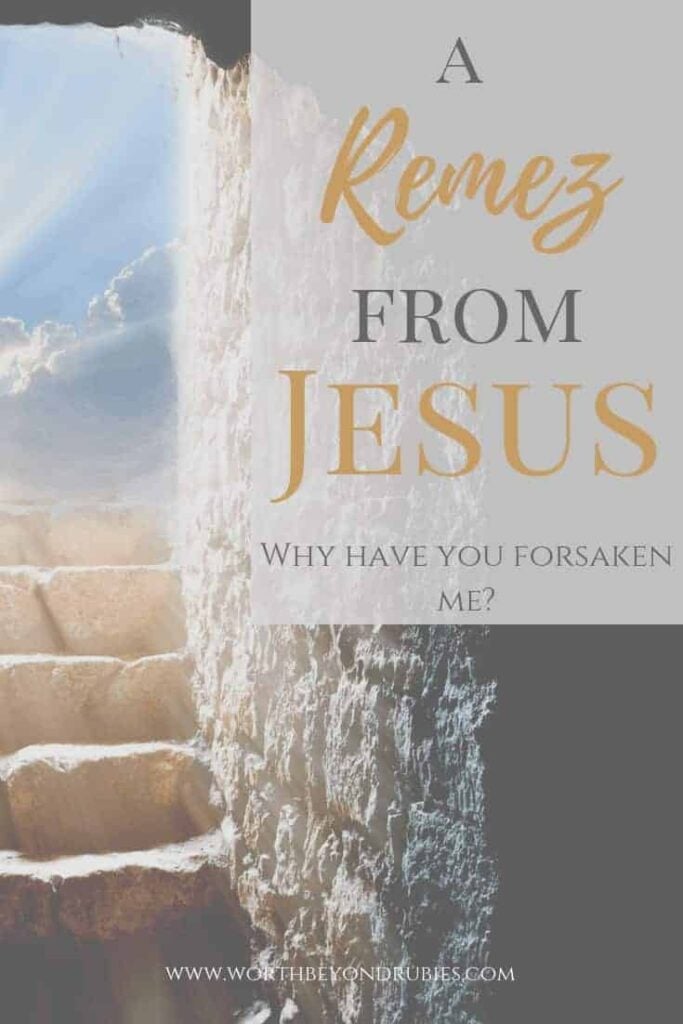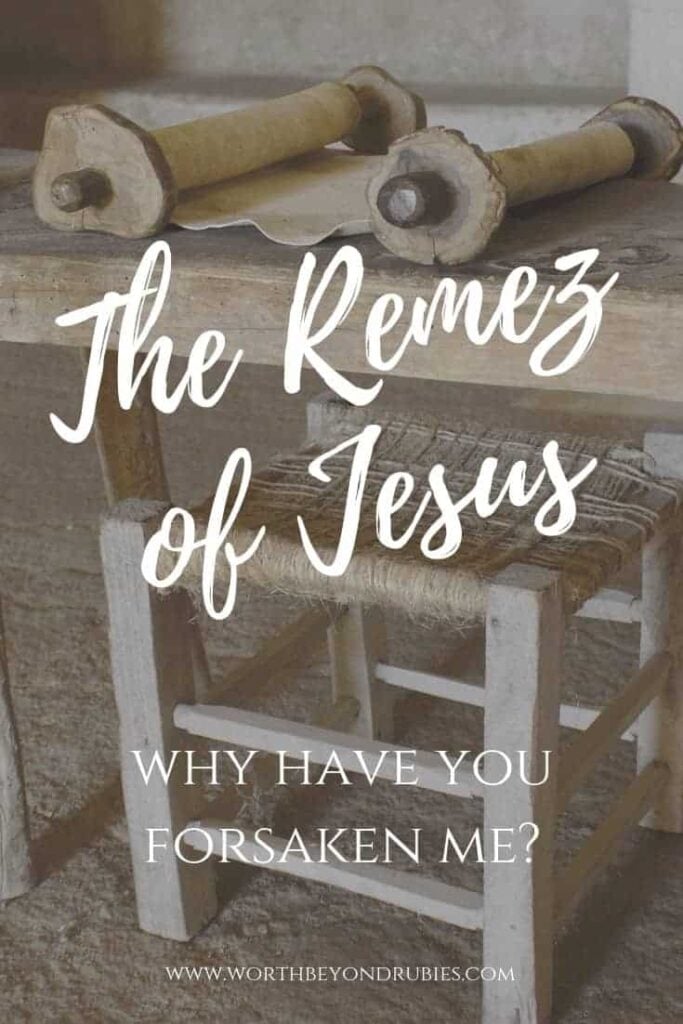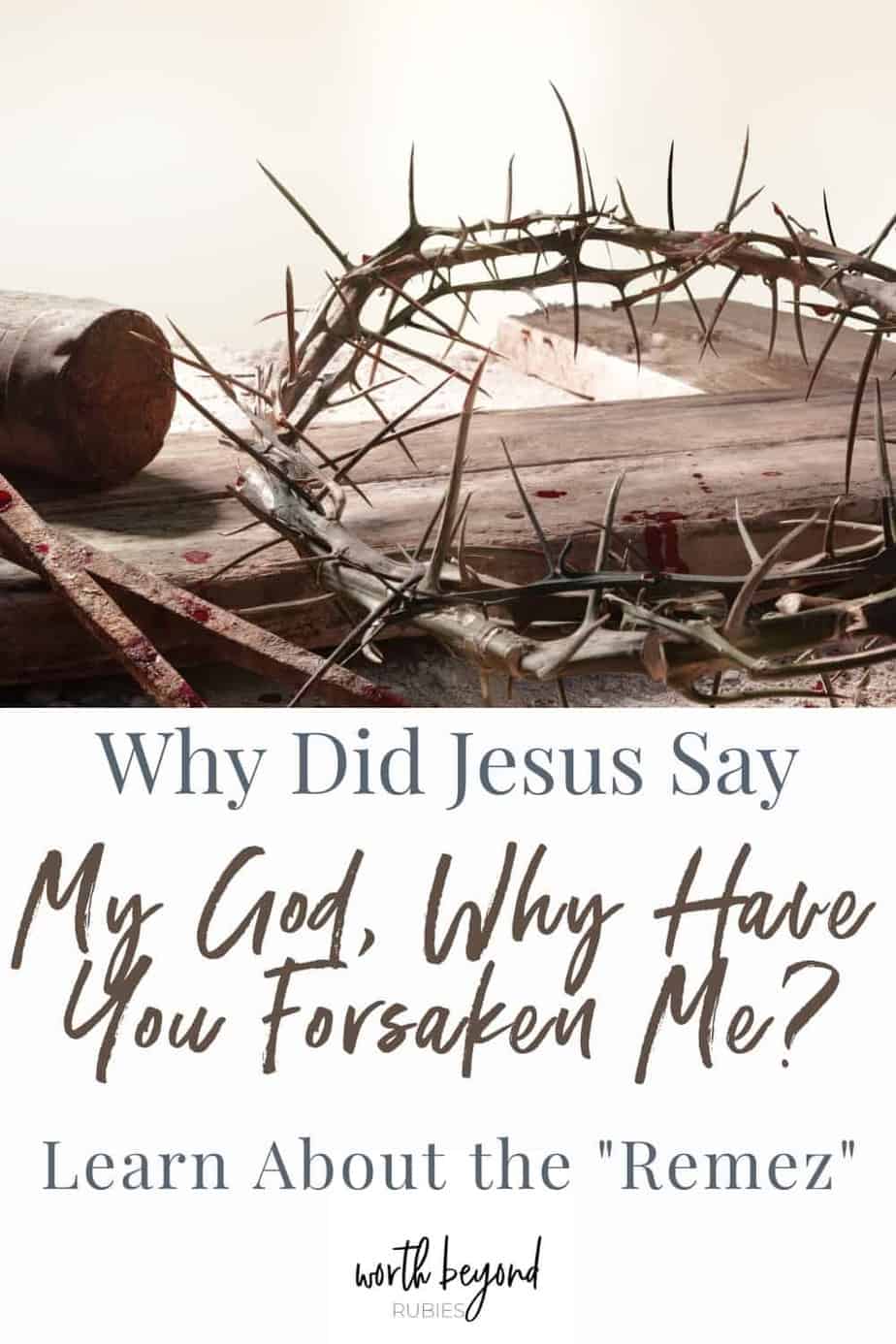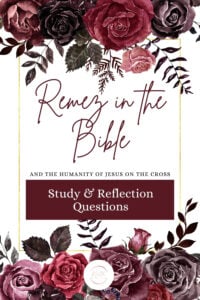Remez in the Bible and the Humanity of Jesus on the Cross
Please note that this article may contain affiliate links. As an Amazon Associate, I earn on qualifying purchases at no additional cost to you. You can read more at the bottom of this page or read my full disclosure on my Affiliate Disclosure Page
The Bible is full of hidden treasures waiting to be uncovered, and one of these treasures is the concept of “remez.” If you’ve ever wondered how Jesus’ words on the cross connect to Old Testament prophecies, you’re in the right place. This post will explore what remez in the Bible means and how it helps us understand the deep connection between Jesus’ humanity and the scriptures He quoted during His crucifixion.
Be sure to grab your FREE Remez in the Bible Study and Reflection Questions for your study binder at the end of this post!
What is Remez?
Remez is a Hebrew word that means “hint” or “suggestion.” In the context of the Bible, remez refers to a teaching technique where a word or phrase hints at something more profound, often pointing to a larger scriptural context.
Imagine it as a gentle nudge that encourages you to look deeper into the scriptures to find hidden meanings. This method is rooted in Jewish tradition and is one of the four ways of interpreting the Bible, known collectively as PaRDeS—an acronym for Peshat (simple meaning), Remez (hint), Drash (inquiry), and Sod (secret) and I will explain that further in a moment.
An example of remez in everyday life could be something as simple as hearing the beginning of a well-known song. For instance, if I were to say to you “Never gonna give you up, never gonma let you down…” most of you likely heard the tune in your head and could complete the line (yes I just Rick Rolled you!). That is how the remez works.
Similarly, when a passage in the Bible uses remez, it’s meant to draw the reader’s attention to a larger story or deeper truth.
Understanding PaRDeS More: The Four Levels of Biblical Interpretation
As mentioned, PaRDeS is an acronym that represents the four traditional levels of interpreting the scriptures in Jewish thought. These methods of interpretation allow for a deeper and more nuanced understanding of the Bible, revealing layers of meaning that go beyond the surface and “dig for the meat” of the Word.
The acronym PaRDeS itself is a Hebrew word that means “orchard” or “garden,” symbolizing the richness and variety of insights that can be gathered from the scriptures. Each level of interpretation offers a different perspective, and together they provide a comprehensive approach to studying the Bible.
- Peshat (פְּשָׁט) – The Simple or Literal Meaning:
- Peshat is the first level of interpretation and refers to the straightforward, plain meaning of the text. It focuses on the literal and grammatical understanding of the words as they appear. This level is concerned with what the text says directly, without looking for hidden meanings or symbolic interpretations. For example, in Genesis 1:1, “In the beginning, God created the heavens and the earth,” the peshat understanding is simply that God is the creator of the universe.
- Remez (רֶמֶז) – The Hint or Allegorical Meaning:
- Remez is the second level of interpretation and refers to a deeper, more symbolic meaning that is hinted at by the text. It goes beyond the literal words to suggest connections with other scriptures or underlying themes. Remez often involves recognizing that a verse or phrase alludes to something more profound, such as a prophecy or a theological concept. For instance, when Yeshua quotes Psalm 22 on the cross, He is using a remez to point His listeners to the entire psalm, which prophesies His suffering and ultimate vindication.
- Drash (דְּרָשׁ) – The Inquired or Midrashic Meaning:
- Drash, also known as midrash, is the third level of interpretation and involves deeper exploration and investigation of the text. It often includes homiletical or sermonic interpretations, where the reader seeks to understand the moral, ethical, or spiritual lessons of the scripture. Drash can also involve comparing different passages to find a coherent message or uncovering a teaching that applies to daily life. An example of drash would be interpreting the story of Abraham’s near-sacrifice of Isaac (the Akedah) as a lesson in faith and obedience to God’s will, beyond its historical or literal meaning.
- Sod (סוֹד) – The Secret or Mystical Meaning:
- Sod is the fourth and deepest level of interpretation, dealing with the hidden or mystical aspects of the text. This level often involves esoteric knowledge, such as Kabbalistic interpretations, where numbers, letters, and symbolic meanings are explored. Sod is concerned with the mysteries of God and the universe that are embedded in the scriptures. For example, the sod interpretation of the number seven in the Bible might explore its significance as a symbol of completeness or divine perfection, which is a recurring theme in both the creation narrative and the Sabbath commandment.
Together, these four levels—Peshat, Remez, Drash, and Sod—provide a holistic approach to understanding the Bible. While Peshat offers clarity and straightforward meaning, Remez invites readers to look for deeper connections, Drash encourages thoughtful reflection and application, and Sod opens the door to the mysteries of the divine.
The beauty of PaRDeS is that it allows the scriptures to speak to readers on multiple levels, offering insights that are both simple and profound, practical and mystical (and by mystical we don’t mean the worldly sense. It literally means “having a spiritual meaning or reality that is not immediately apparent to the senses or the mind.” (Miriam Webster)).
Through PaRDeS, believers can engage with the Bible in a way that nourishes the mind, heart, and soul, revealing the fullness of God’s word.
The Purpose of Jesus’ Remez on the Cross: A Remez to Psalm 22
Hanging on the cross was an excruciating ordeal that put immense strain on Yeshua’s body. The position of crucifixion stretched His arms outwards, causing His chest muscles and diaphragm to become paralyzed.
This made breathing incredibly difficult because the only way to take in air was to push up on the nails driven through His feet, forcing His body upwards to expand His lungs. Each breath required Yeshua to endure searing pain as He strained against the nails and the wood scraping along His back as he fought the intense pressure in His chest.
The simple act of speaking while on the cross would have required extraordinary effort, making every word He uttered—especially His cry of “My God, my God, why have You forsaken me?”—a powerful testament to His enduring will and determination to fulfill His mission.
When Yeshua cried out, “My God, my God, why have You forsaken me?” He wasn’t just expressing His deep anguish; He was strategically using a remez to convey a profound message. By quoting the first verse of Psalm 22, Yeshua was pointing His listeners—especially the religious leaders and those well-versed in scripture—towards the entire psalm.
Psalm 22 begins with a cry of abandonment but ultimately unfolds as a vivid prophecy of the Messiah’s suffering and ends with a declaration of God’s deliverance.
Yeshua’s use of remez served multiple purposes. First, it was a way of asserting His identity as the Messiah. By directing the minds of His audience to Psalm 22, He was revealing that His crucifixion was not a defeat, but a fulfillment of prophecy.
The psalm details specific aspects of the crucifixion, such as the piercing of hands and feet and the casting of lots for clothing—events that were unfolding right before their eyes. This was Yeshua’s way of saying, “Look at what is happening and remember what was foretold. This is part of God’s plan.”
Second, the remez was a subtle but powerful call to faith. For those who recognized the reference, it was a reminder that even in the darkest moments, God is in control. Psalm 22 transitions from despair to trust, ending in praise and hope.
By invoking this psalm, Yeshua was signaling that His suffering would lead to victory, not just for Himself, but for all who would believe in Him. It was a message of hope in the face of despair, emphasizing that God’s promises are always fulfilled.
In essence, Yeshua’s use of remez on the cross was a way to communicate to those who understood the scriptures that His death was not the end, but the beginning of the fulfillment of God’s redemptive plan. It underscored His messianic identity and invited His followers to see the crucifixion not as a moment of defeat, but as the prophesied path to ultimate victory and salvation.
The Prophetic Fulfillment
Psalm 22, written by King David, vividly describes the suffering of someone who is mocked, surrounded by enemies, and enduring physical torment. These descriptions are strikingly similar to what Yeshua experienced on the cross.
As I said, when He referenced this psalm, Jesus was showing that His suffering wasn’t just a tragic event—it was the fulfillment of prophecy, proving that He was the Messiah foretold in the scriptures. This use of the remez connects the Old Testament to the New Testament in a powerful way, demonstrating the continuity of God’s plan for salvation.

The Overlooked Humanity of Jesus
It’s easy to focus on Yeshua’s divinity, but His humanity is just as important, especially when considering His suffering on the cross. The pain and emotional agony He went through weren’t just symbolic; they were very real. Yeshua felt every bit of that pain, just as any human would. His cry of abandonment reflects the depth of His human experience, reminding us that He truly walked in our shoes.
Understanding Jesus’ humanity is crucial because it means He knows what it’s like to suffer, to feel abandoned, and to experience fear.
This makes Him not just a distant divine figure but someone who deeply understands our struggles and can empathize with us in our darkest moments.
Balancing Divinity and Humanity
The balance between Jesus’ divinity and humanity is key to understanding the full significance of the crucifixion. While He was the Son of God, He was also fully human, experiencing pain, suffering, and even death. His cry from the cross highlights this humanity, yet it also reaffirms His divine mission to fulfill the scriptures. Recognizing this balance helps us appreciate the depth of Jesus’ sacrifice and the unique role He plays as Messiah.
Why Jesus’ Humanity Matters
Jesus’ humanity matters because it means He can truly relate to us. Hebrews 4:15 tells us that Jesus can sympathize with our weaknesses because He has been tempted and suffered just as we do, yet without sin.
Knowing this can bring great comfort, especially when we face our own struggles. Jesus’ experience of suffering and abandonment on the cross shows that He is with us in our pain, offering not just sympathy but a deep understanding of what we’re going through.
The Dual Significance of Jesus’ Cry
Jesus’ cry from the cross serves two important purposes: it asserts His identity as the Messiah and resonates with the human experience of feeling forsaken. By quoting Psalm 22, Jesus was making a clear statement about who He was and what His suffering meant.
At the same time, His words reflect a very human emotion—one that many of us can relate to. This dual significance makes His cry one of the most powerful moments in the Bible, as it connects His divine mission with His human experience.
Reflecting on the Cross Today
Understanding remez in the Bible and recognizing Jesus’ humanity on the cross can deepen our appreciation for the scriptures and the message of the Gospel. The Bible is a richly interconnected text, with each part contributing to a larger story of God’s love and redemption.
Personal Application
As we reflect on the cross, we can find comfort in knowing that Jesus understands our pain and suffering. His cry of abandonment encourages us to bring our own struggles to God, trusting that He hears us and will help us through our trials. Recognizing the use of remez and understanding Jesus’ humanity can deepen our faith and draw us closer to Him. In every hardship, we can look to Jesus’ example on the cross and find hope, knowing that He is both our Savior and our empathetic companion in suffering.
FAQ Section
Q: What does “Remez” mean in the context of the Bible? A: Remez is a Hebrew term meaning “hint.” It refers to a method of biblical interpretation where a word or phrase in scripture hints at a deeper, often prophetic, meaning, connecting to other passages within the Bible.
Q: How did Jesus use Remez on the cross? A: Jesus used Remez by quoting Psalm 22:1 when He cried out, “My God, my God, why have You forsaken me?” This allusion pointed to the entire psalm, which is a prophecy about the suffering and eventual vindication of the Messiah.
Q: Why is it important to understand Jesus’ humanity? A: Understanding Jesus’ humanity is crucial because it allows believers to relate to Him on a personal level. His experiences of suffering and abandonment make Him an empathetic Savior who fully understands human pain and struggles.
Q: How does Psalm 22 connect to the crucifixion of Jesus? A: Psalm 22 contains prophetic details about the suffering of the Messiah, including the piercing of hands and feet and the casting of lots for His clothing. These were fulfilled in Jesus’ crucifixion, highlighting Him as the prophesied Messiah.
Q: What theological significance does Jesus’ cry from the cross have? A: Jesus’ cry from the cross has deep theological significance as it asserts His messianic identity through Remez, fulfills Old Testament prophecy, and connects His suffering to the universal human experience of feeling forsaken.
Don’t forget to grab your FREE Remez in the Bible Study and Reflection Questions below!





Great post!
I remember hearing so many in Christian circles declare that the sin on Christ’s ‘shoulders’ was so great that the Father had to turn His face away, and then someone quotes Jesus quoting Psalm 22 as proof.
One day at a Bible Study, we were cautioned about how we sometimes have to look close at these things we always say, because we don’t always think them through or check the Scriptures. Then that same night, the conversation about the Father turning His face away happened. I said, “Hey, I think if we look at the Scriptures, we’ll find no proof that it actually says that. In fact, it seems the opposite. Isaiah tells us that it pleased the Lord to crush him; Revelation tells us He’s the Lamb slain before the foundation of the world; Paul tells us this is the fulfillment of everything that was promised and the mystery of God that has been coming together for ages, and is now revealed. It’s all part of God’s plan… so I don’t think it’s something that He can’t bear to look at.”
Later I realized that Psalm 22:24 – in the passage Jesus is quoting – plainly states, “He has not despised or abhorred the affliction of the afflicted, and he has not hidden his face from him, but has heard him, when he cried to him.” Literally the opposite of what we often hear.
I’ve also heard (but need to confirm) that the “He has done it” at the end of Psalm 22 in the Septuagint is the same Greek word (maybe root word) for the declaration, “It is finished!”
One of the men there later came to me and told me he had looked at it more and agreed with me, then told me about “Remez” as a technique. It seems so clear that Jesus was giving a massive “hint” to those watching.
It’s powerful to think that no matter how great our sin, the love and grace of God is so much greater — that nothing we do is so powerful as to cause God to turn His face away, but that His mercies and grace are so powerful as to look right at all the worst humanity has to offer and pay the debt through His shed blood.
Haha, sorry for the long rant, but I’m happy I found your post from just two weeks ago… Psalm 22 is the subject of our church Bible Study tonight, and I was just looking up remez to prepare and refresh my memory on this passage.
Thank you for your comments Dave. I think sometimes there is a tendency to “read” Christian thought into prophetic language. We want things to fit but the reality is that the reality is not always nice and neat. A study into the prophetic leads us oftentimes into the literary and into prose and into language that isn’t quite so simple. I appreciate you leaning more into those things!
Thank you for this article, I have been looking for information on Jesus’ Jewish teaching methods. Currently, I am a seminary student wanting to integrate this into a paper. However, my seminary, from what I can find, has no information on this subject. While I do agree with what you have said, my professor would not accept this as “academic.” Do you have any sources that could be used on a seminary level paper concerning Remez and Pardes?
There are some on Sefaria that you might find useful. You can do a search for the word remez. Much is in Hebrew but there are some in English. Here is one. https://www.sefaria.org/Kedushat_Levi%2C_Genesis%2C_Bereshit?ven=Kedushat_Levi_translated_by_Rb._Eliyahu_Munk&lang=bi
You sort of have to sort through the various teachings on it as some were used in teaching Torah and some became used in Kabbalah as well.
There is an article called The Place of Story and Storytelling in Messianic Jewish Ministry: Rediscovering the Lost Treasures of Hebraic Narrative by Bill Bjoraker published in the Kesher Journal in Jan 2, 2018 that touches a tiny bit on it.
Chabad.org I am sure has some as well. Since it is a a rabbinical method, rabbinical sources are likely going to be the only good sources. It was something I learned through the years so I don’t know many specific sources but I will go through my library here at home and see if I can find anything for you as well.
The rabbis, who knew Psalm 22 well, actually quoted from the psalm before Jesus answered. They used verses 7 and 8 to mock Jesus. “All who see me mock me; they hurl insults shaking their heads. “He trusts in the Lord,” they say, “let the Lord rescue him. Let him deliver him since he delights in him.”
And Jesus, in one last response to the religious leaders quoted from the beginning of the chapter. Brilliant. Then comes v 24 that confirms the love of his father. So good.